
M-7002 User Manual, Rev: 1.0 2012/04/11
1
M-7002
User Manual
ICP DAS CO., LTD.
Revision: 1.0
2012/04/11

M-7002 User Manual, Rev: 1.0 2012/04/11
2
Table of Contents
1.
Introduction............................................................................................5
1.1.
Pin Assignments ............................................................................6
1.2.
Specifications.................................................................................7
1.3.
Block Diagram...............................................................................9
1.4.
Application Wiring......................................................................10
1.5.
Default Settings............................................................................11
1.6.
Calibration ...................................................................................12
1.6.1
Analog Input......................................................................12
1.7.
Configuration Tables...................................................................13
2.
DCON Protocol....................................................................................16
2.1.
%AANNTTCCFF........................................................................20
2.2.
#**................................................................................................22
2.3.
#AA..............................................................................................24
2.4.
#AAN...........................................................................................26
2.5.
$AA0............................................................................................28
2.6.
$AA1............................................................................................30
2.7.
$AA2............................................................................................32
2.8.
$AA4............................................................................................34
2.9.
$AA5............................................................................................36
2.10.
$AA5VV......................................................................................38
2.11.
$AA6............................................................................................40
2.12.
$AA7CiRrr...................................................................................42
2.13.
$AA8Ci........................................................................................44
2.14.
$AAC...........................................................................................46
2.15.
$AAF ...........................................................................................47
2.16.
$AAI ............................................................................................48
2.17.
$AALS.........................................................................................50
2.18.
$AAM..........................................................................................52
2.19.
$AAP ...........................................................................................53
2.20.
$AAPN.........................................................................................55
2.21.
$AAS1 .........................................................................................57
2.22.
~** ...............................................................................................59
2.23.
~AA0............................................................................................60
2.24.
~AA1............................................................................................62
2.25.
~AA2............................................................................................64
2.26.
~AA3EVV...................................................................................66
2.27.
~AA4............................................................................................68
2.28.
~AA5PPSS...................................................................................70
2.29.
~AAD...........................................................................................72
2.30.
~AADVV.....................................................................................74
2.31.
~AAEV........................................................................................76

M-7002 User Manual, Rev: 1.0 2012/04/11
3
2.32.
~AAI............................................................................................78
2.33.
~AAO(Data) ................................................................................80
2.34.
~AARD........................................................................................82
2.35.
~AARDTT...................................................................................84
2.36.
~AATnn.......................................................................................86
2.37.
@AACECi...................................................................................88
2.38.
@AACH ......................................................................................90
2.39.
@AACHi .....................................................................................92
2.40.
@AACHCi...................................................................................94
2.41.
@AACL.......................................................................................96
2.42.
@AACLi......................................................................................98
2.43.
@AACLCi.................................................................................100
2.44.
@AADA....................................................................................102
2.45.
@AADI......................................................................................104
2.46.
@AADODD ..............................................................................106
2.47.
@AAEAt....................................................................................108
2.48.
@AAHI(Data)Ci........................................................................110
2.49.
@AALO(Data)Ci.......................................................................112
2.50.
@AARAO..................................................................................114
2.51.
@AARECi.................................................................................116
2.52.
@AARH ....................................................................................118
2.53.
@AARHi ...................................................................................120
2.54.
@AARHCi.................................................................................122
2.55.
@AARL.....................................................................................124
2.56.
@AARLi....................................................................................126
2.57.
@AARLCi.................................................................................128
3.
Modbus RTU Protocol.......................................................................130
3.1.
02 (0x02) Read the Digital Input Status....................................131
3.2.
04 (0x04) Read the Analog Input Channels..............................132
3.3.
05 (0x05) Write a Single Digital Output...................................133
3.4.
70 (0x46) Read/Write Module Settings.....................................134
3.4.1
Sub-function 00 (0x00) Read the module name .............135
3.4.2
Sub-function 04 (0x04) Set the module address.............136
3.4.3
Sub-function 05 (0x05) Read the communication settings
.........................................................................................137
3.4.4
Sub-function 06 (0x06) Set the communication settings 138
3.4.5
Sub-function 07 (0x07) Read the type code....................139
3.4.6
Sub-function 08 (0x08) Set the type code.......................140
3.4.7
Sub-function 32 (0x20) Read the firmware version........141
3.4.8
Sub-function 37 (0x25) Read the channel enabled/disabled
status................................................................................142
3.4.9
Sub-function 38 (0x26) Set the channel to enabled/disabled
.........................................................................................143

M-7002 User Manual, Rev: 1.0 2012/04/11
4
3.4.10
Sub-function 41 (0x29) Read the miscellaneous settings144
3.4.11
Sub-function 42 (0x2A) Write the miscellaneous settings
.........................................................................................145
3.5.
Address Mappings.....................................................................146
3.6.
Engineering Data Format Table ................................................149
4.
Troubleshooting..................................................................................150
4.1.
Communicating with the module ..............................................150
4.2.
Reading Data..............................................................................151
5.
Appendix ............................................................................................152
5.1.
INIT Mode.................................................................................152
5.2.
Dual Watchdog Operation.........................................................154
5.3.
Frame Ground............................................................................155
5.4.
Node Information Area..............................................................157
5.5.
Reset Status................................................................................158

M-7002 User Manual, Rev: 1.0 2012/04/11
5
1. Introduction
Features
• Voltage or Current Input
• +/-240 Vrms Overvoltage Protection
• High Resolution: 16-bit
• 2500 V
DC
Intra-module Isolation
• Sink and Source Type Digital Inputs
• Photocoupler Isolation
• Supports Relay Outputs
• DIN-Rail Mountable
• Dual Watchdog
• Wide Operating Temperature Range: -25 ~ +75°C
Applications
• Building Automation
• Factory Automation
• Machine Automation
• Remote Maintenance
• Remote Diagnosis
• Testing Equipment
More Information
Refer to Chapter 1 of the “I-7000 Bus Converter User Manual”
for more information regarding the following:
1.1. I-7000 Overview
1.2. I-7000 Related Documentation
1.3. I-7000 Common Features
1.4. I-7000 System Network Configuration
1.5. I-7000 Dimensions

M-7002 User Manual, Rev: 1.0 2012/04/11
6
1.1. Pin Assignments

M-7002 User Manual, Rev: 1.0 2012/04/11
7
1.2. Specifications
System Specifications
Communication
Interface RS-485
Format N, 8, 1
Baud Rate 1200 ~ 115200 bps
Protocol DCON / Modbus RTU
Dual Watchdog
Yes, Module (1.6 Seconds), Communication
(Programmable)
LED Indicator/Display
System LED Indicator Yes, 1 LED as Power/Communication Indicator
I/O LED Indicator -
7-Segment LED Display -
Isolation
Intra-Module Isolation, Field-
to-Logic
2500 V
DC
EMS Protection
ESD (IEC 61000-4-2) +/-4 kV
EFT (IEC 61000-4-4) +/-4 kV
Surge (IEC 61000-4-5) +/-3 kV
Power
Reverse Polarity Protection Yes
Input Voltage Range 10 ~ 30 V
DC
Consumption 1.8 W
Mechanical
Dimensions (W x L x H) 72 mm x 123 mm x 35 mm
Installation DIN-Rail or Wall Mounting
Environment
Operating Temperature -25 ~ +75°C
Storage Temperature -40 ~ +85°C
Humidity 10 ~ 95% RH, Non-condensing

M-7002 User Manual, Rev: 1.0 2012/04/11
8
I/O Specifications
Analog Input
Channels 4
Wiring Differential
Input Range
+/-150 mV, +/-500 mV, +/-1 V , +/-5 V, +/-10 V
+/-20 mA , 0~20 mA, 4~20 mA (jumper selectable)
Resolution 12/16-bit
Normal Mode 0.1%
Accuracy
Fast Mode 0.5%
Normal Mode 10 Hz
Sampling Rate
Fast Mode 60 Hz
Voltage 2 MΩ Input
Impedance
Current 139 Ω
Common Voltage Protection +/-200 V
DC
Individual Channel
Configuration
Yes
Overcurrent Protection 50 mA max. at 110 V
DC
/V
AC
max.
Overvoltage Protection 240 Vrms
Digital Input/Counter
Channels 5
Contact Wet
Sink/Source (NPN/PNP) Sink/Source
On Voltage Level 10 ~ 50 V
DC
Off Voltage Level +4 V
DC
Max.
Counter (50 Hz, 16-bit) Yes
Input Impedance 10 kΩ
Overvoltage Protection +/-70 V
DC
Isolation Voltage 3750 V
DC
Relay Output
Channels 4
Type Power Relay (Form A)
Contact Rating
5 A @ 250 V
AC
5 A @ 30 V
DC
Surge Strength 3000 V
DC
Operation Time 6 ms
Release Time 3 ms
Mechanical Endurance 2 × 10
7
ops.
Electrical Endurance 10
5
ops.
Power-on Values Yes
Safe Values Yes

M-7002 User Manual, Rev: 1.0 2012/04/11
9
1.3. Block Diagram

M-7002 User Manual, Rev: 1.0 2012/04/11
10
1.4. Application Wiring
Digital
Input/Counter
Read back as 1 Read back as 0
+10 ~ +50 V
DC
OPEN or < 4 V
Sink
+10 ~ +50 V
DC
OPEN or < 4 V
Source
Voltage Input Wire Connection Current Input Wire Connection
Power Relay
ON State
Read back as 1
OFF State
Read back as 0
Relay On Relay Off
Relay Output

M-7002 User Manual, Rev: 1.0 2012/04/11
11
1.5. Default Settings
The default settings for the M-7002 are:
▫ Module address: 01
▫ Analog input type: Type 08, -10V to 10V
▫ Protocol: Modbus protocol
▫ Baud Rate: 9600 bps
▫ Checksum disabled
▫ Engineering units format
▫ Filter set at 60Hz rejection

M-7002 User Manual, Rev: 1.0 2012/04/11
12
1.6. Calibration
Warning: It is not recommended that calibration be
performed until the process is fully understood.
1.6.1 Analog Input
The calibration procedure is as follows:
1. Warm up the module for 30 minutes.
2. Set the type code to the type you want to calibrate.
Refer to Section 2.12 for details.
3. Enable calibration. Refer to Section 2.31 for details.
4. Apply the zero calibration voltage/current.
5. Send the “zero calibration” command. Refer to Section
2.6 for details.
6. Apply the span calibration voltage/current.
7. Send the “span calibration” command. Refer to Section
2.5 for details.
8. Repeat steps 3 to 7 three times.
Notes:
1. Connect the calibration voltage/current to channel 0.
2. When calibrating type 0D, the jumper for channel 0
should be set to the “current input” position.
3. Calibration voltages and currents are shown below.
Calibration voltage/current:
Type
Code
08 09 0A 0B 0C 0D
Zero
Input
0 V 0 V 0 V 0 mV 0 mV 0 mA
Span
Input
+10 V +5 V +1 V +500 mV
+150 mV
+20 mA

M-7002 User Manual, Rev: 1.0 2012/04/11
13
1.7. Configuration Tables
Baud Rate Settings (CC)
Bits 5:0
Code
03 04 05 06 07 08 09 0A
Baud Rate
1200
2400
4800
9600
19200
38400
57600
115200
Bits 7:6
00: no parity, 1 stop bit
01: no parity, 2 stop bits
10: even parity, 1 stop bit
11: odd parity, 1 stop bit
Analog Input Type Settings (TT)
Type Code
Analog Input Type Range
07 +4 ~ +20 mA +4 mA ~ +20 mA
08 +/-10 V -10 V ~ +10 V
09 +/-5 V -5 V ~ +5 V
0A +/-1 V -1 V ~ +1 V
0B +/-500 mV -500mV ~ +500 mV
0C +/-150 mV -150 mV ~ +150 mV
0D +/-20 mA -20 mA ~ +20 mA
1A 0 ~ +20 mA 0 ~ +20 mA
Note:
When types 07, 0D or 1A are selected, the jumper for the
corresponding channel should be set to the “current input”
position.

M-7002 User Manual, Rev: 1.0 2012/04/11
14
Data Format Settings (FF)
7 6 5 4 3 2 1 0
FS CS MS Reserved DF
Key Description
DF Data format
00: Engineering units
01: % of FSR (full scale range)
10: 2’s complement hexadecimal
MS Mode settings
0: Normal mode (16 bits)
1: Fast mode (12 bits)
CS Checksum settings
0: Disabled
1: Enabled
FS Filter settings
0: 60Hz rejection
1: 50Hz rejection
Note: Reserved bits should be zero.

M-7002 User Manual, Rev: 1.0 2012/04/11
15
Analog Input Type and Data Format Table
Type code
Input Type Data Format +F.S -F.S.
Engineering units
+20.000 +04.000
% of FSR +100.00 +000.00
07
+4 to +20
mA
2’s comp HEX FFFF 0000
Engineering units
+10.000 -10.000
% of FSR +100.00 -100.00
08
-10 to +10
V
2’s comp HEX 7FFF 8000
Engineering units
+5.0000 -5.0000
% of FSR +100.00 -100.00
09
-5 to +5
V
2’s comp HEX 7FFF 8000
Engineering units
+1.0000 -1.0000
% of FSR +100.00 -100.00
0A
-1 to +1
V
2’s comp HEX 7FFF 8000
Engineering units
+500.00 -500.00
% of FSR +100.00 -100.00
0B
-500 to +500
mV
2’s comp HEX 7FFF 8000
Engineering units
+150.00 -150.00
% of FSR +100.00 -100.00
0C
-150 to +150
mV
2’s comp HEX 7FFF 8000
Engineering units
+20.000 -20.000
% of FSR +100.00 -100.00
2’s comp HEX 7FFF 8000
0D
-20 to +20
mA
2’s comp HEX 7FFF A99A
Engineering units
+20.000 +00.000
% of FSR +100.00 +000.00
1A
0 to +20
mA
2’s comp HEX FFFF 0000

M-7002 User Manual, Rev: 1.0 2012/04/11
16
2.
DCON Protocol
All communication with the module consists of commands
generated by the host and responses transmitted by the
module. Each module has a unique ID number that is used
for addressing purposes and is stored in non-volatile
memory. The ID is 01 by default and can be changed by
transmitting the appropriate using a user command. All
commands to the modules contain the ID address,
meaning that only the addressed module will respond. The
only exception to this is command #** (Section 2.2) and
command ~** (Section 2.22), which is sent to all modules,
but, in these cases, the modules do not reply to the
command.
Command Format:
Leading
Character
Module
Address
Command
[CHKSUM]
CR
Response Format:
Leading
Character
Module
Address
Data [CHKSUM]
CR
CHKSUM A 2-character checksum that is present
when the checksum setting is enabled. See
Sections 2.1 and 5.1 for details.
CR End of command character, carriage return
(0x0D)

M-7002 User Manual, Rev: 1.0 2012/04/11
17
Checksum Calculation:
1. Calculate the ASCII code sum of all the characters in
the command/response string, except for the carriage
return character (CR).
2. The checksum is equal to the sum masked by 0FFh.
Example:
Command string: $012(CR)
1. The sum of the string = “$”+”0”+”1”+”2” =
24h+30h+31h+32h = B7h
2. Therefore the checksum is B7h, and so
CHKSUM = “B7”
3. The command string with the checksum = $012B7(CR)
Response string: !01200600(CR)
1. The sum of the string =
“!”+”0”+”1”+”2”+”0”+”0”+”6”+”0”+”0” =
21h+30h+31h+32h+30h+30h+36h+30h+30h = 1AAh
2. Therefore the checksum is AAh, and so
CHKSUM = “AA”
3. The response string with the checksum
= !01200600AA(CR)
Note:
All characters should be in upper case.

M-7002 User Manual, Rev: 1.0 2012/04/11
18
General Command Sets
Command Response Description Section
%AANNTTCCFF !AA Sets the configuration of the module 2.1
$AA2 !AANNTTCCFF
Reads the configuration of the module 2.7
$AA5 !AAS Reads the reset status of the module 2.9
$AAC !AA Clears the DI/DO latches of the module 2.14
$AAF !AA(Data) Reads the firmware version information 2.15
$AAI !AAS Reads the status of the INIT switch 2.16
$AALS !(Data) Reads the status of the DI and DO latches 2.17
$AAM !AA(Data) Reads the name of the module 2.18
$AAP !AASC Reads the communication protocol 2.19
$AAPN !AA Sets the communication protocol 2.20
~AAD !AAVV Reads the miscellaneous settings 2.29
~AADVV !AA Sets the miscellaneous settings 2.30
~AAI !AA
Sets the software INIT modification to
enabled
2.32
~AAO(Data) !AA Sets the name of the module 2.33
~AARD !AATT Reads the response delay time 2.34
~AARDTT !AA Sets the response delay time 2.35
~AATnn !AA Sets the Software INIT timeout value 2.36
@AACECi !AA Clears the DI counter 2.37
@AADI !AAOOII Reads the status of the DO and DI channels
2.45
@AADODD !AA Sets the status of the DO channels 2.46
@AARECi !AA Reads the counter for a specific DI channel 2.51
Analog Input Command Sets
Command Response Description Section
#** No Response Synchronized sampling 2.2
#AA >(Data) Reads the analog inputs of all channels 2.3
#AAN >(Data) Reads the analog input of a specific channel
2.4
$AA0 !AA Performs an analog input span calibration 2.5
$AA1 !AA Performs an analog input zero calibration 2.6
$AA4 >AAS(Data) Reads the synchronized data 2.8
$AA5VV !AA Enables/Disables the analog input channels
2.10
$AA6 !AAVV
Reads the enabled/disabled status of all
analog input channels
2.11
$AA7CiRrr !AA Sets the type code for a specific channel 2.12
$AA8Ci !AACiRrr Reads the type code for a specific channel 2.13

M-7002 User Manual, Rev: 1.0 2012/04/11
19
$AAS1 !AA Reloads the default calibration parameters 2.21
~AAEV !AA
Enables/Disables the analog input
calibration
2.31
@AACH !AA Clears the high latch value for all channels 2.38
@AACHi !AA
Clears the high latch value for a specific
channel
2.39
@AACHCi !AA Clears the status of the high alarm 2.40
@AACL !AA Clears the low latch value for all channels 2.41
@AACLi !AA
Clears the low latch value for a specific
channel
2.42
@AACLCi !AA Clears the status of the low alarm 2.43
@AADA !AA Disables the analog input alarm 2.44
@AAEAt !AA Enables the momentary/latch function 2.47
@AAHI(Data)Ci !AA Sets the analog input high alarm 2.48
@AALO(Data)Ci !AA Sets the analog input low alarm 2.49
@AARAO !AAHHLL
Reads the activated alarms associated with
the DO channels of a module
2.50
@AARH !AA(Data) Reads the high latch value for all channels 2.52
@AARHi !AA(Data)
Reads the high latch value for a specific
channel
2.53
@AARHCi !AA(Data)
Reads the status of the analog input high
alarm
2.54
@AARL !AA(Data) Reads the low latch value for all channels 2.55
@AARLi !AA(Data)
Reads the low latch value for a specific
channel
2.56
@AARLCi !AA(Data)
Reads the status of the analog input low
alarm
2.57
Host Watchdog Command Sets
Command Response Description Section
~** No Response Informs all modules that host is OK 2.22
~AA0 !AASS Reads the status of the Host Watchdog 2.23
~AA1 !AA Resets the status of the Host Watchdog 2.24
~AA2 !AAEVV Reads the Host Watchdog timeout settings 2.25
~AA3EVV !AA Sets the Host Watchdog timeout settings 2.26
~AA4 !AAPPSS
Reads the DO power-on value and the safe
value
2.27
~AA5PPSS !AA
Sets the DO power-on value and the safe
value
2.28

M-7002 User Manual, Rev: 1.0 2012/04/11
20
2.1. %AANNTTCCFF
Description:
This command is used to set the configuration for a
specific module.
Syntax:
%AANNTTCCFF[CHKSUM](CR)
% Delimiter character
AA The address of the module to be configured in
hexadecimal format (00 to FF)
NN The new address of the module in hexadecimal
format (00 to FF)
TT Not used by the M-7002 and should be set to 00.
CC The new Baud Rate code, see Section 1.7 for
details. To change the Baud Rate, the module
should first be switched to INIT* mode.
FF The command used to set the data format,
checksum, and filter settings. See Section 1.7 for
details of the data format. To change the
checksum settings, the module should first be
switched to INIT* mode.
Response:
Valid Response: !AA[CHKSUM](CR)
Invalid Response: ?AA[CHKSUM](CR)
! Delimiter for a valid response
? Delimiter for an invalid response
(If the Baud Rate or checksum settings are
changed without first switching to INIT* mode,
the module will return an invalid response.)
AA The address of the responding module in
hexadecimal format (00 to FF)
Page is loading ...
Page is loading ...
Page is loading ...
Page is loading ...
Page is loading ...
Page is loading ...
Page is loading ...
Page is loading ...
Page is loading ...
Page is loading ...
Page is loading ...
Page is loading ...
Page is loading ...
Page is loading ...
Page is loading ...
Page is loading ...
Page is loading ...
Page is loading ...
Page is loading ...
Page is loading ...
Page is loading ...
Page is loading ...
Page is loading ...
Page is loading ...
Page is loading ...
Page is loading ...
Page is loading ...
Page is loading ...
Page is loading ...
Page is loading ...
Page is loading ...
Page is loading ...
Page is loading ...
Page is loading ...
Page is loading ...
Page is loading ...
Page is loading ...
Page is loading ...
Page is loading ...
Page is loading ...
Page is loading ...
Page is loading ...
Page is loading ...
Page is loading ...
Page is loading ...
Page is loading ...
Page is loading ...
Page is loading ...
Page is loading ...
Page is loading ...
Page is loading ...
Page is loading ...
Page is loading ...
Page is loading ...
Page is loading ...
Page is loading ...
Page is loading ...
Page is loading ...
Page is loading ...
Page is loading ...
Page is loading ...
Page is loading ...
Page is loading ...
Page is loading ...
Page is loading ...
Page is loading ...
Page is loading ...
Page is loading ...
Page is loading ...
Page is loading ...
Page is loading ...
Page is loading ...
Page is loading ...
Page is loading ...
Page is loading ...
Page is loading ...
Page is loading ...
Page is loading ...
Page is loading ...
Page is loading ...
Page is loading ...
Page is loading ...
Page is loading ...
Page is loading ...
Page is loading ...
Page is loading ...
Page is loading ...
Page is loading ...
Page is loading ...
Page is loading ...
Page is loading ...
Page is loading ...
Page is loading ...
Page is loading ...
Page is loading ...
Page is loading ...
Page is loading ...
Page is loading ...
Page is loading ...
Page is loading ...
Page is loading ...
Page is loading ...
Page is loading ...
Page is loading ...
Page is loading ...
Page is loading ...
Page is loading ...
Page is loading ...
Page is loading ...
Page is loading ...
Page is loading ...
Page is loading ...
Page is loading ...
Page is loading ...
Page is loading ...
Page is loading ...
Page is loading ...
Page is loading ...
Page is loading ...
Page is loading ...
Page is loading ...
Page is loading ...
Page is loading ...
Page is loading ...
Page is loading ...
Page is loading ...
Page is loading ...
Page is loading ...
Page is loading ...
Page is loading ...
Page is loading ...
Page is loading ...
Page is loading ...
Page is loading ...
Page is loading ...
Page is loading ...
Page is loading ...
Page is loading ...
-
 1
1
-
 2
2
-
 3
3
-
 4
4
-
 5
5
-
 6
6
-
 7
7
-
 8
8
-
 9
9
-
 10
10
-
 11
11
-
 12
12
-
 13
13
-
 14
14
-
 15
15
-
 16
16
-
 17
17
-
 18
18
-
 19
19
-
 20
20
-
 21
21
-
 22
22
-
 23
23
-
 24
24
-
 25
25
-
 26
26
-
 27
27
-
 28
28
-
 29
29
-
 30
30
-
 31
31
-
 32
32
-
 33
33
-
 34
34
-
 35
35
-
 36
36
-
 37
37
-
 38
38
-
 39
39
-
 40
40
-
 41
41
-
 42
42
-
 43
43
-
 44
44
-
 45
45
-
 46
46
-
 47
47
-
 48
48
-
 49
49
-
 50
50
-
 51
51
-
 52
52
-
 53
53
-
 54
54
-
 55
55
-
 56
56
-
 57
57
-
 58
58
-
 59
59
-
 60
60
-
 61
61
-
 62
62
-
 63
63
-
 64
64
-
 65
65
-
 66
66
-
 67
67
-
 68
68
-
 69
69
-
 70
70
-
 71
71
-
 72
72
-
 73
73
-
 74
74
-
 75
75
-
 76
76
-
 77
77
-
 78
78
-
 79
79
-
 80
80
-
 81
81
-
 82
82
-
 83
83
-
 84
84
-
 85
85
-
 86
86
-
 87
87
-
 88
88
-
 89
89
-
 90
90
-
 91
91
-
 92
92
-
 93
93
-
 94
94
-
 95
95
-
 96
96
-
 97
97
-
 98
98
-
 99
99
-
 100
100
-
 101
101
-
 102
102
-
 103
103
-
 104
104
-
 105
105
-
 106
106
-
 107
107
-
 108
108
-
 109
109
-
 110
110
-
 111
111
-
 112
112
-
 113
113
-
 114
114
-
 115
115
-
 116
116
-
 117
117
-
 118
118
-
 119
119
-
 120
120
-
 121
121
-
 122
122
-
 123
123
-
 124
124
-
 125
125
-
 126
126
-
 127
127
-
 128
128
-
 129
129
-
 130
130
-
 131
131
-
 132
132
-
 133
133
-
 134
134
-
 135
135
-
 136
136
-
 137
137
-
 138
138
-
 139
139
-
 140
140
-
 141
141
-
 142
142
-
 143
143
-
 144
144
-
 145
145
-
 146
146
-
 147
147
-
 148
148
-
 149
149
-
 150
150
-
 151
151
-
 152
152
-
 153
153
-
 154
154
-
 155
155
-
 156
156
-
 157
157
-
 158
158
ICP DAS USA M-7002 - Data Acquisition Module with Analog Input, Digital Input and Relay Output, communicable over RS-485 and Modbus RTU. User manual
- Type
- User manual
- This manual is also suitable for
Ask a question and I''ll find the answer in the document
Finding information in a document is now easier with AI
Related papers
-
ICP DAS USA M-7015 User manual
-
ICP DAS USA M-7033D User manual
-
ICP DAS USA tM-TH8 User manual
-
ICP DAS USA M-7018R User manual
-
ICP DAS USA M-7005 - 8-channel Thermistor Analog Input and 6-channel Digital Output Data Acquisition Module, supports Modbus RTU and RS-485 User manual
-
ICP DAS USA M-7017R User manual
-
ICP DAS USA M-7017 User manual
-
ICP DAS USA M-7019Z-S2 User manual
-
ICP DAS USA M-7017RMS User manual
-
ICP DAS USA M-7019R - 8-channel Thermocouple, Current and Voltage Analog Input Module, Communicates over RS-485 and Modbus RTU. User manual
Other documents
-
ICP M-6018-16 User manual
-
ICP M-2017 User manual
-
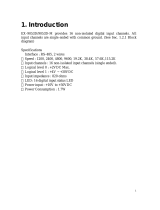 ExpertDAQ EX9053D User manual
ExpertDAQ EX9053D User manual
-
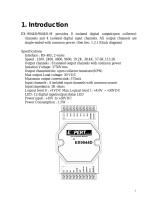 ExpertDAQ EX9044D User manual
ExpertDAQ EX9044D User manual
-
Advantech Network Card ADAM 4000 User manual
-
 ExpertDAQ EX-9060D-M User manual
ExpertDAQ EX-9060D-M User manual
-
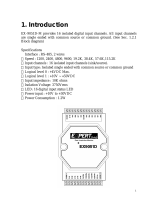 ExpertDAQ EX9055D-M User manual
ExpertDAQ EX9055D-M User manual
-
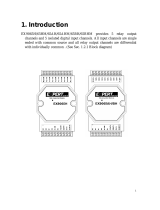 ExpertDAQ EX9065BHD-M User manual
ExpertDAQ EX9065BHD-M User manual
-
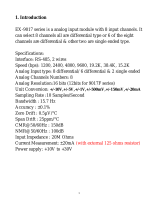 ExpertDAQ EX9017F User manual
ExpertDAQ EX9017F User manual
-
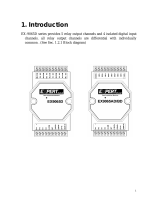 ExpertDAQ EX9065B User manual
ExpertDAQ EX9065B User manual




































































































































































